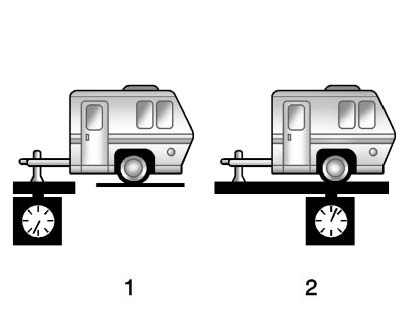Chevrolet Cruze Owners Manual: Trailer Towing (Except Fuel Economy Model)
Before pulling a trailer, there are three important considerations that have
to do with weight:
• The weight of the trailer.
• The weight of the trailer tongue.
• The total weight on your vehicle's tires.
Weight of the Trailer
How heavy can a trailer safely be? It should never weigh more than 454 kg (1,000 lbs). But even that can be too heavy.
It depends on how the rig is used.
For example, speed, altitude, road grades, outside temperature, and how much the vehicle is used to pull a trailer are all important. It can depend on any special equipment on the vehicle, and the amount of tongue weight the vehicle can carry.
See “Weight of the Trailer Tongue” later in this section.
Maximum trailer weight is calculated assuming only the driver is in the tow vehicle and it has all the required trailering equipment. The weight of additional optional equipment, passengers, and cargo in the tow vehicle must be subtracted from the maximum trailer weight.
Ask your dealer for trailering information or advice .
Weight of the Trailer Tongue
The tongue load (1) of any trailer is an important weight to measure because it affects the total gross weight of the vehicle. The Gross Vehicle Weight (GVW) includes the curb weight of the vehicle, any cargo carried in it, and the people who will be riding in the vehicle.
If there are a lot of options, equipment, passengers, or cargo in the vehicle, it will reduce the tongue weight the vehicle can carry, which will also reduce the trailer weight the vehicle can tow. If towing a trailer, the tongue load must be added to the GVW because the vehicle will be carrying that weight, too.

The trailer tongue (1) should weigh 10 to 15 percent of the total loaded trailer weight (2).
After loading the trailer, weigh the trailer and then the tongue, separately, to see if the weights are proper. If they are not, adjustments might be made by moving some items around in the trailer.
Total Weight on Your Vehicle's Tires
Be sure the vehicle's tires are inflated to the upper limit for cold tires. These numbers can be found on the Tire and Loading Information label. Make sure not to go over the GVW limit for the vehicle, including the weight of the trailer tongue.
 Trailer Towing (Fuel Economy Model)
Trailer Towing (Fuel Economy Model)
The vehicle is neither designed nor intended to tow a trailer. ...
 Towing Equipment
Towing Equipment
Hitches
Use the correct hitch equipment.
See your dealer or a hitch dealer for assistance.
• The rear bumper on the vehicle is not intended for hitches. Do not attach
rental hitches or othe ...
Other materials:
Air Conditioning Compressor and Condenser Hose Replacement (1.6L LXT)
Removal Procedure
Recover the refrigerant. Refer to Refrigerant Rec overy and
Recharging.
Remove front bumper fascia. Refer to Front Bumper Fascia Replacement.
Remove A/C compressor and condenser hose nut (1) from A/C condensor (2).
Remove A/C compressor and ...
Charging System Light
The charging system light comes on briefly when the ignition is turned on, but
the engine is not running, as a check to show the light is working.
The light turns off when the engine is started. If it does not, have the vehicle
serviced by your dealer.
If the light stays on, or comes on whil ...
Cigarette Lighter
For vehicles with a cigarette lighter, it is on the center floor console near
the shift lever.
To activate the cigarette lighter, push it into the heating element and let go.
When the lighter is ready it will pop back out.
Notice: Holding a cigarette lighter in while it is heating does not
l ...
